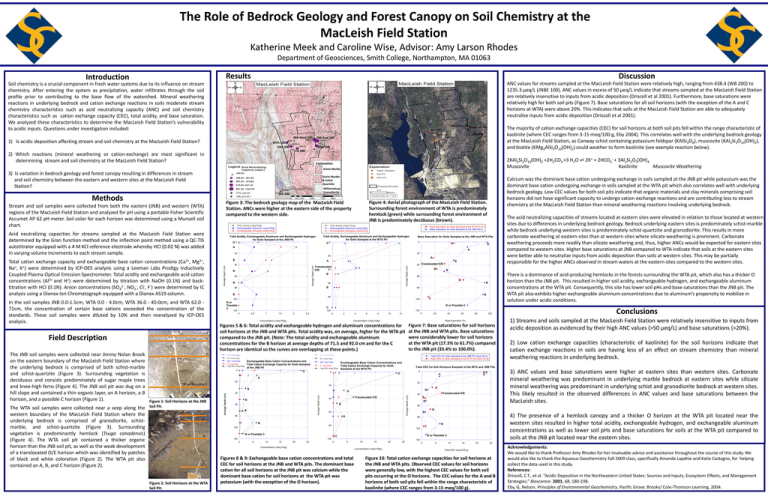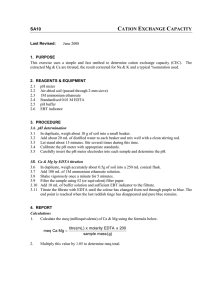The Role of Bedrock Geology and Forest Canopy on Soil Chemistry... MacLeish Field Station Introduction
advertisement

The Role of Bedrock Geology and Forest Canopy on Soil Chemistry at the MacLeish Field Station Katherine Meek and Caroline Wise, Advisor: Amy Larson Rhodes Department of Geosciences, Smith College, Northampton, MA 01063 Results Introduction Discussion ANC values for streams sampled at the MacLeish Field Station were relatively high, ranging from 438.4 (WB 200) to 1235.3 μeq/L (JNBE 100). ANC values in excess of 50 μeq/L indicate that streams sampled at the MacLeish Field Station are relatively insensitive to inputs from acidic deposition (Driscoll et al 2001). Furthermore, base saturations were relatively high for both soil pits (Figure 7). Base saturations for all soil horizons (with the exception of the A and C horizons at WTA) were above 20%. This indicates that soils at the MacLeish Field Station are able to adequately neutralize inputs from acidic deposition (Driscoll et al 2001). Soil chemistry is a crucial component in fresh water systems due to its influence on stream chemistry. After entering the system as precipitation, water infiltrates through the soil profile prior to contributing to the base flow of the watershed. Mineral weathering reactions in underlying bedrock and cation exchange reactions in soils moderate stream chemistry characteristics such as acid neutralizing capacity (ANC) and soil chemistry characteristics such as cation exchange capacity (CEC), total acidity, and base saturation. We analyzed these characteristics to determine the MacLeish Field Station’s vulnerability to acidic inputs. Questions under investigation included: JNB-West 100 1) Is acidic deposition affecting stream and soil chemistry at the MacLeish Field Station? JNB-East 100 735.9 WTA 100 ONS 250 The majority of cation exchange capacities (CEC) for soil horizons at both soil pits fell within the range characteristic of kaolinite (where CEC ranges from 3-15 meq/100 g, Eby 2004). This correlates well with the underlying bedrock geology at the MacLeish Field Station, as Conway schist containing potassium feldspar (KAlSi3O8), muscovite (KAl3Si3O10(OH)2), and biotite (KMg3AlSi3O10(OH)2) could weather to form kaolinite (see example reaction below). 1235.3 JNB 200 FG 200 2) Which reactions (mineral weathering or cation-exchange) are most significant in determining stream and soil chemistry at the MacLeish Field Station? 2KAl3Si3O10(OH)2 +2H2CO3 +3 H2O ⇌ 2K+ + 2HCO3- + 3Al2Si2O5(OH)4 Muscovite Kaolinite Muscovite Weathering Explanation Schist Marble 3) Is variation in bedrock geology and forest canopy resulting in differences in stream and soil chemistry between the eastern and western sites at the MacLeish Field Station? WB 200 Methods Total Acidity (meq/100g) Exchangeable Aluminum (meq/100g) Exchangeable Hydrogen (meq/100g) Acid neutralizing capacities for streams sampled at the MacLeish Field Station were determined by the Gran function method and the inflection point method using a QC-TIS autotitrator equipped with a 4 M KCl reference electrode whereby HCl (0.02 N) was added in varying volume increments to each stream sample. In the soil samples JNB 0.0-1.5cm, WTA 0.0 - 4.0cm, WTA 36.0 - 40.0cm, and WTA 62.0 71cm, the concentration of certain base cations exceeded the concentration of the standards. These soil samples were diluted by 10% and then reanalyzed by ICP-OES analysis. Field Description Total Acidity, Exchangeable Aluminum and Exchangeable Hydrogen for Soils Sampled at the WTA Pit 0 O Base Saturation for Soils Sampled at the JNB and WTA Pits 0 O O A 20 20 20 B A A B 60 B B Translocated 40 O/E Average Depth (cm) Average Depth (cm) 40 B 60 B 80 40 Translocated O/E B B B 80 B B or Possible C C 120 120 100 0 0.5 1 1.5 2 2.5 0 2 4 Concentration (meq/100g) 6 8 10 0 12 2+ 20 Ca (meq/100g) + 2+ Exchangeable Base Cation Concentrations and Total Cation Exchange Capacity for Soils Sampled at the JNB Pit O + K (meq/100g) Total CEC (meq/100g) 0 60 80 100 Base Saturation (%) Figure 7: Base saturations for soil horizons at the JNB and WTA pits. Base saturations were considerably lower for soil horizons at the WTA pit (17.3% to 61.7%) compared to the JNB pit (33.4% to 100.0%). (meq/100g) Total CEC for Soils Sampled at the JNB Pit (meq/100 g) Total CEC for Soils Sampled at the WTA Pit (meq/100 g) Na+ (meq/100g) Na (meq/100g) Mg2+ (meq/100g) 40 Concentration (meq/100g) Figures 5 & 6: Total acidity and exchangeable hydrogen and aluminum concentrations for soil horizons at the JNB and WTA pits. Total acidity was, on average, higher for the WTA pit compared to the JNB pit. (Note: The total acidity and exchangeable aluminum concentrations for the B horizon at average depths of 71.5 and 92.0 cm and for the C horizon are identical so the curves are overlapping at these points.) Ca C 100 100 B or Possible C There is a dominance of acid-producing hemlocks in the forests surrounding the WTA pit, which also has a thicker O horizon than the JNB pit. This resulted in higher soil acidity, exchangeable hydrogen, and exchangeable aluminum concentrations at the WTA pit. Consequently, this site has lower soil pHs and base saturations than the JNB pit. The WTA pit also exhibits higher exchangeable aluminum concentrations due to aluminum’s propensity to mobilize in solution under acidic conditions. 60 80 Mg2+ (meq/100g) + K (meq/100g) Total CEC (meq/100g) Exchangeable Base Cation Concentrations and Total Cation Exchange Capacity for Soils Sampled at the WTA Pit 0 0 O A 20 O 20 60 B 80 B 60 B B Translocated O/E 40 B B B B B or Possible C 100 0 5 10 15 20 25 0 B C C 120 4) The presence of a hemlock canopy and a thicker O horizon at the WTA pit located near the western sites resulted in higher total acidity, exchangeable hydrogen, and exchangeable aluminum concentrations as well as lower soil pHs and base saturations for soils at the WTA pit compared to soils at the JNB pit located near the eastern sites. 80 100 B or Possible C 5 Concentration (meq/100g) Figures 8 & 9: Exchangeable base cation concentrations and total CEC for soil horizons at the JNB and WTA pits. The dominant base cation for all soil horizons at the JNB pit was calcium while the dominant base cation for soil horizons at the WTA pit was potassium (with the exception of the O horizon). 10 15 Concentration (meq/100g) 20 2) Low cation exchange capacities (characteristic of kaolinite) for the soil horizons indicate that cation exchange reactions in soils are having less of an effect on stream chemistry than mineral weathering reactions in underlying bedrock. 60 80 100 Figure 2: Soil Horizons at the WTA Soil Pit. Average Depth (cm) Average Depth (cm) Figure 1: Soil Horizons at the JNB Soil Pit. Translocated O/E 40 A B A 40 1) Streams and soils sampled at the MacLeish Field Station were relatively insensitive to inputs from acidic deposition as evidenced by their high ANC values (>50 μeq/L) and base saturations (>20%). 3) ANC values and base saturations were higher at eastern sites than western sites. Carbonate mineral weathering was predominant in underlying marble bedrock at eastern sites while silicate mineral weathering was predominant in underlying schist and granodiorite bedrock at western sites. This likely resulted in the observed differences in ANC values and base saturations between the MacLeish sites. O 20 B Conclusions Total CEC for Soil Horizons Sampled at the WTA and JNB Pits A B The acid neutralizing capacities of streams located at eastern sites were elevated in relation to those located at western sites due to differences in underlying bedrock geology. Bedrock underlying eastern sites is predominately schist-marble while bedrock underlying western sites is predominately schist-quartzite and granodiorite. This results in more carbonate weathering at eastern sites than at western sites where silicate weathering is prominent. Carbonate weathering proceeds more readily than silicate weathering and, thus, higher ANCs would be expected for eastern sites compared to western sites. Higher base saturations at JNB compared to WTA indicate that soils at the eastern sites were better able to neutralize inputs from acidic deposition than soils at western sites. This may be partially responsible for the higher ANCs observed in stream waters at the eastern sites compared to the western sites. B B Average Depth (cm) The WTA soil samples were collected near a seep along the western boundary of the MacLeish Field Station where the underlying bedrock is comprised of granodiorite, schistmarble, and schist-quartzite (Figure 3). Surrounding vegetation is predominantly hemlock (Tsuga canadensis) (Figure 4). The WTA soil pit contained a thicker organic horizon than the JNB soil pit, as well as the weak development of a translocated O/E horizon which was identified by patches of black and white coloration (Figure 2). The WTA pit also contained an A, B, and C horizon (Figure 2). Base Saturation for Soils Sampled at the WTA Pit (%) Base Saturation for Soils Sampled at the JNB Pit(%) A Average Depth (cm) Total cation exchange capacity and exchangeable base cation concentrations (Ca2+, Mg2+, Na+, K+) were determined by ICP-OES analysis using a Leeman Labs Prodigy Inductively Coupled Plasma Optical Emission Spectrometer. Total acidity and exchangeable acid cation concentrations (Al3+ and H+) were determined by titration with NaOH (0.1N) and backtitration with HCl (0.1N). Anion concentrations (SO42-, NO3-, Cl-, F-) were determined by IC analysis using a Dionex Ion Chromatograph equipped with a Dionex AS19 column. Total Acidity (meq/100 g) Exchangeable Aluminum (meq/100g) Exchangeable Hydrogen (meq/100 g) Total Acidity, Exchangeable Aluminum and Exchangeable Hydrogen for Soils Sampled at the JNB Pit O0 Calcium was the dominant base cation undergoing exchange in soils sampled at the JNB pit while potassium was the dominant base cation undergoing exchange in soils sampled at the WTA pit which also correlates well with underlying bedrock geology. Low CEC values for both soil pits indicate that organic materials and clay minerals comprising soil horizons did not have significant capacity to undergo cation exchange reactions and are contributing less to stream chemistry at the MacLeish Field Station than mineral weathering reactions involving underlying bedrock. Figure 4: Aerial photograph of the MacLeish Field Station. Surrounding forest environment of WTA is predominately hemlock (green) while surrounding forest environment of JNB is predominately deciduous (brown). Figure 3: The bedrock geology map of the MacLeish Field Station. ANCs were higher at the eastern side of the property compared to the western side. Stream and soil samples were collected from both the eastern (JNB) and western (WTA) regions of the MacLeish Field Station and analyzed for pH using a portable Fisher Scientific Accumet AP 62 pH meter. Soil color for each horizon was determined using a Munsell soil chart. The JNB soil samples were collected near Jimmy Nolan Brook on the eastern boundary of the MacLeish Field Station where the underlying bedrock is comprised of both schist-marble and schist-quartzite (Figure 3). Surrounding vegetation is deciduous and consists predominately of sugar maple trees and knee-high ferns (Figure 4). The JNB soil pit was dug on a hill slope and contained a thin organic layer, an A horizon, a B horizon, and a possible C horizon (Figure 1). Schist Marble & Schist , Quartzite Williamsburg Granodiorite 25 120 0 5 10 15 20 25 Total CEC (meq/100 g) Figure 10: Total cation exchange capacities for soil horizons at the JNB and WTA pits. Observed CEC values for soil horizons were generally low, with the highest CEC values for both soil pits occurring at the O horizons. The CEC values for the A and B horizons of both soil pits fell within the range characteristic of kaolinite (where CEC ranges from 3-15 meq/100 g). Acknowledgements: We would like to thank Professor Amy Rhodes for her invaluable advice and assistance throughout the course of this study. We would also like to thank the Aqueous Geochemistry Fall 2009 class, specifically Amanda Lapahie and Katie Castagno, for helping collect the data used in this study. References: Driscoll, C.T., et al. “Acidic Deposition in the Northeastern United States: Sources and Inputs, Ecosystem Effects, and Management Strategies.” Bioscience. 2001, 68, 180-198. Eby, G, Nelson. Principles of Environmental Geochemistry. Pacific Grove: Brooks/ Cole-Thomson Learning, 2004.





